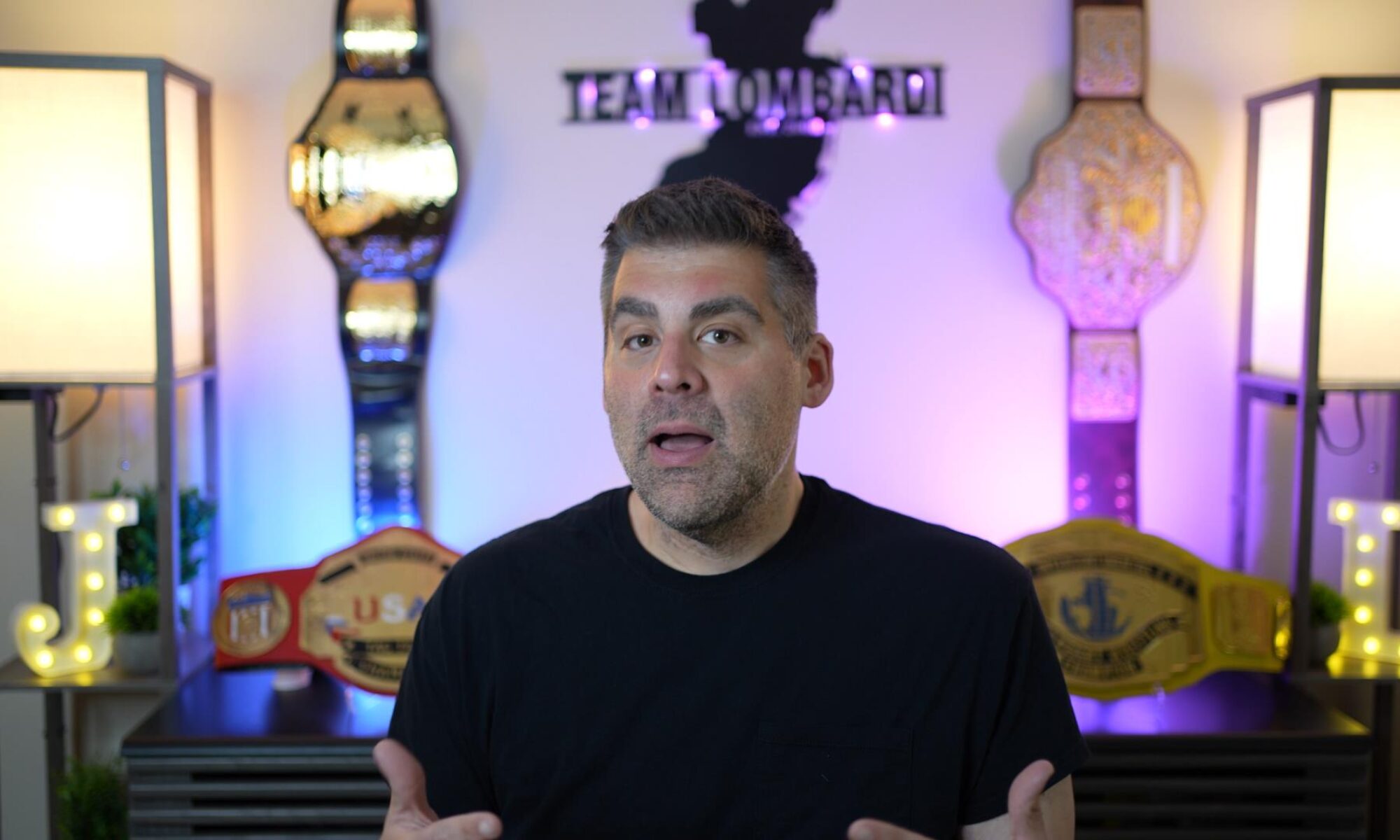BeezCast: Episode 01: What the Beez?
You can’t ignore climate change

I recently started reading Tom Friedman’s book Thank You for Being Late. He lays out a timeline of technological accelerations (like AI and the growth of high speed bandwidth globally) that I thought would be good information for my podcast.
Mr. Friedman devoted a chapter to climate change in the book and paints a fairly horrific picture that got me thinking about the climate, especially in the United State’s current political situation.
The Earth is 4.5 billion years old. For the vast majority of the planet’s existence, the climate was not be hospitable for humans (the first billion years our planet couldn’t support the simplest life).
Human beings showed up 200,000 years ago. Civilization as we know it started around 6,000 years ago. An interesting fact about this timeline is that the planet shifted into the Holocene epoch around 11,000 years ago.
First what is an epoch?
In geochronology, an epoch is a subdivision of the geologic timescale that is longer than an age and shorter than a period. Rock layers deposited during an epoch are called a series.
Basically geologists study layers of rock to determine different changes in the chemical composition of the earth at different times (air, water, etc). Humans developed functional society during the Holocene epoch:
The Holocene also encompasses the growth and impacts of the human species worldwide, including all its written history, development of major civilizations, and overall significant transition toward urban living in the present.
Do you think the Holocene being a climate friendly period to human life and the proliferation of civilization is a coincidence? Earth’s current temperatures haven’t been this hot since the Eemian period 120,000 years ago (sea levels were 20-30 ft higher).
Everything was fairly balanced until the last 200 years. It seems humans have created so much concrete, chemicals, and unnatural materials like plastics that the planet is literally covered in a new layer of man-made dirt that is starting to be called the Anthropocene epoch.
This is exciting for geologists but will probably be bad for everybody else.
The industrial age is the origin point to this story. We figured out how to make more: more food, more materials for housing, better clothing, better medicine. Because there was abundance, there was more people.
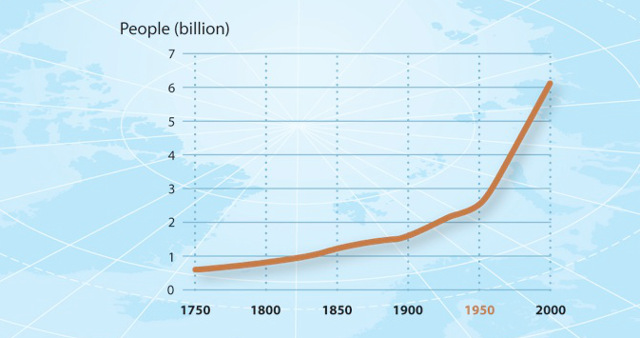
The population doubled in the last 50 years. The UN is projecting that there will be almost 10 billion people on the planet by 2050.
This growth is being driven by the obvious countries like India and China, but more than 50% of that growth is expected by African countries like Nigeria. The population of the African continent could reach 4.2 billion by 2100.
More people are consuming more of everything (food and materials), which is causing even more impact to the environment. More production, more cows, more fishing means more carbon dioxide in the air and water and (most likely) consuming more trees.
Speaking of plant life, the use of pesticides and fertilizer has leached so many chemicals into the water tables that existing plants are not performing as well as they did at consuming carbon dioxide and there are less of them around.
The increase in green house gases is leading the ice caps to melt. Less ice at the caps mean less reflection of the sun’s rays which leads to more ice melting and the overall water temperature to heat up. This totally messes up ocean currents and causes insane weather patterns and super-storms.
The ice is also releasing even more CO2 gas (that was trapped during pre-human periods) and is increasing the acidity of the ocean which is impacting coral reef and fish populations.
So what does it all mean? Take the most extreme scenario off the table (all the ice melts), just a few feet causes major geo-political problems. Rising water means less coasts which forces huge groups of people to relocate. A continent like Africa which is already resource constrained, in a seemingly constant state of political unrest, and is experiencing a population boom… it is a recipe for disaster.
The climate problem is a political issue. A distracted and quarreling world population will not be in a position to address the environmental problems to ensure future generations can thrive.
Longing for the return of coal mines instead of investing in renewable resources is troubling (since it is becoming cheaper to produce nationally). But solar and wind aren’t going to get the job done in the short term which is why there needs to be investments in nuclear or molten salt reactors.
The global population has to figure out how to get CO2 out of the air and water ASAP. This is problematic considering that fossil fuels account for 87% of China’s energy consumption. Even though China is being praised for their investment in renewables, they are still going to burn a massive amount of coal (about 4 billion tons vs. 1 billion in the US) to keep growing economically.
Why am I taking the time to write a 1000 words on the topic? This entire situation scares me. My wife and I probably won’t live to see the most problematic aspects of climate change, but my son and his children will.
I don’t understand how politicians can see what is happening in Greenland, at the polar caps, and observe the extreme weather we have experience the last decade and deny there is a problem. Humans have literally changed the world over the last 200 years in the worst possible context.
Forget the two-party system, they are all responsible for this situation. This “kick the can down the road” mentality is a death sentence for future generations and will undoubtedly become the ignition point for future global warfare (what happens when we run out of fresh water?).
We have to elect people who acknowledge there is a problem and actually have a plan to start dealing with it.
Besides elections, here are some other ways to address climate change as an individual:
- Get informed via GreenPeace
- Make simple changes in your home that consume less energy
- Use renewable sources of energy when possible
- Don’t upgrade your phone as often and eat less meat (don’t punch me in the face on those last two)
Update (1/20/2017): It hasn’t been 8 hours since Trump assumed office and the official White House website has dropped any mention of climate change.
Photo: John Towner
Farewell BabyCenter
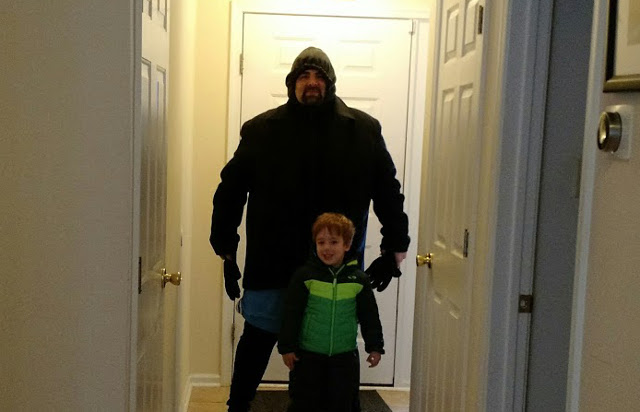
I made a quick comment about this on Facebook the other day, but I wanted to formally announce that my time writing for BabyCenter is over.
Normally this time on a Sunday morning, I am searching news feeds for ideas for my (mostly) weekly article about parenting and raising a child, but the pressure is off. After (exactly) four years, I will no longer be writing for BabyCenter.
I have been running out of steam for the last few months… feeling like I have been repeating myself and covering the same general topics. My (excellent) BabyCenter editors are also looking to go into a specific direction and so we came to a very natural parting of the ways.
The editors (past and present) and writers on BabyCenter were kind, encouraging, and pretty darn wonderful. This experience was a much needed change from some of the previous blogging experiences I had at other sites.
From a writing perspective, I learned restraint. I couldn’t rely on my natural tone and had to change my style to match the audience. At times I found that frustrating, but overall, I am very proud that I didn’t follow my more base instincts.
That learned-restraint has been reused and refined on my weekly podcast.
Besides writing, I learned a great deal about operating a blog, getting better awareness for posts, and more than I ever wanted to know about usage rights for pictures (you can’t put the genie back into the bottle).
My main online project The Source has been growing in popularity this year and this newfound “extra time” on Sunday mornings will be spent improving that project as well as creating content for this blog right here (which I have been neglecting).
Thank you for reading and supporting my articles at BabyCenter, I never imagined I would be writing there for four years. Special thanks to Amy H, Amy G, Betsy, and Dina for the feedback and support you provided over the years.
If you want to keep tabs on me… follow me here, at The Source, and on twitter.
Photo: Allison
Christmas Gift Idea: Make a better NES Mini
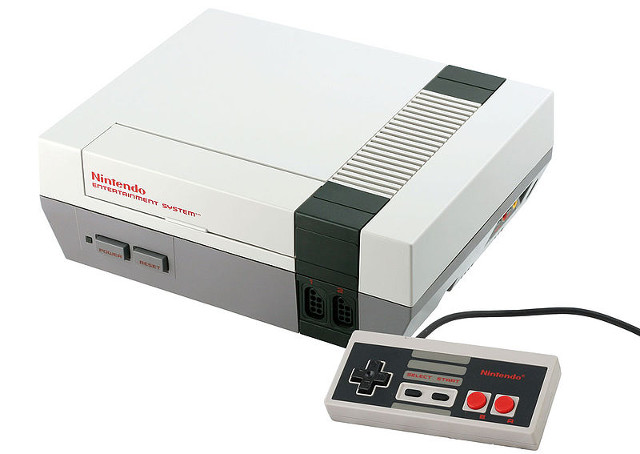
The Nintendo Classic Mini has caught the world’s attention. This retro device from Nintendo allows buyers play 30 classic Nintendo games like Super Mario, Zelda, and Metroid.
Our friends from Japan did not anticipate the demand for these nostalgic devices.
If you have a need to show your kids these classic games, you don’t have to wait until retailers get them back in stock. With a little bit of time and elbow grease, you can build your own mini game system that does much more than the limited mini (even though that thing has great hardware).
What you need:
- Raspberry Pi 3B: This little computer board will power the system ($35)
- A Case for RPi: I like this one – you don’t even need a screw driver ($7)
- A Micro SD card ($12)
- If you don’t have a spare Micro USB charger around, you need one of those too.
- USB Gaming Controllers: This project supports PS3 controllers which are my preference, but if you want a retro feel, check these out.
What you need to do:
- Lifehacker.com put together spectacular instructions on how to do this project, I cannot improve upon it. They will tell you everything you need to know. But I will provide links to the software you need.
- Download the Retropie image
- Download the Win32DiskImager program so you can install the software on the SD Card
I built a few of these devices over the last few months, and it has become so much easier to get them set up in the most recent 4.1 version. I should also warn you – you will need a USB keyboard to help with the first configuration.
You might be asking, where do I get the games? If you search the term “Nintendo Roms” you will find places to get them. Emulator ethics states that you should own the games in their original format before downloading a copy.
Photo: Wikipedia
Cutting the cord

I cut the cord this week and said goodbye to Comcast television and phone.
I am going to tell you how I did it and the services I am using to replace what I eliminated. But first I am going to tell you why…
People like to scream about how terrible Comcast is as a company and from a customer service perspective, but I can honestly say whenever I had a problem in the 8 years they have been in the house, they fixed it pretty quickly.
So if the service wasn’t bad, why did I cancel a bunch of stuff? I was paying $222.21 per month.
I do not live in an area where I can get another internet provider. I would be stuck with DSL, which is just unacceptable speed. I can get dish TV or something like that, but Verizon Fios isn’t an option in my area.
I had TV/internet/phone with 3 cable boxes, a cable modem ($40 in equipment rental fees), and I subscribed to the DVR service after a promotion that “saved me money”. I started with a triple play package at $99 per month and over the years it inflated to well over $200.
I called Comcast two weeks ago to negotiate and reduce my bill. They took $20 off (which was not a victory in my book), but later in the day, I found out they cut service to one of the televisions in the house. When I got it fixed, the bill went back to the starting price.
I don’t really watch much television. I would rather be reading, writing, and making stuff. My son is an avid user of Netflix and Hulu. My wife was the biggest issue as she is a content grazer and channel flipper. I walked her through my plan and she eventually got on board.
The biggest selling point: I went from $222.21 to $87(ish) per month (not including the streaming services).
Products I am using:
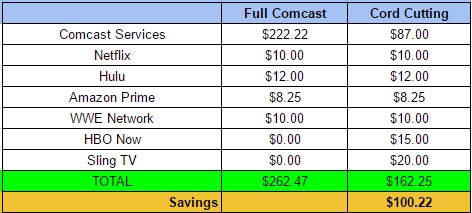
I decided that one clear method to save is to stop renting equipment from Comcast, including the modem. For my home and the setup that I prefer, I needed a modem, a router, and a streaming device for every television. I was thinking about buying a Ooma for phone, but my friend tipped me off to another device that I will get to later.
This this is what I purchased:
- Modem: Arris Surfboard SB6183 ($97) – Part of my $87 dollars with Comcast is a faster internet, I wanted to make sure I had a modem that supported faster speeds, so I opted for the SB6183 over the SB6141.
- Router: ASUS RT-AC66U ($132) – I already have one of these routers in my home, I installed a 2nd router a while ago to ensure I have great coverage throughout the house. I thought about getting Google’s On Hub, but it was more expensive and I would have to get a small switch to network all of my back office devices together. Important to note that both the router and modem support gigabit networking.
- Streaming Device: Roku 4 ($133) – If you have a preference go with it. I selected the Roku 4 because it supports 4K streaming and is provider agnostic (works with Netflix, Amazon, Hulu, HBO, Google). I also like that it has an optical out to support older audio equipment that might only have HDMI pass-through.
- Streaming Device: Amazon Fire TV ($85) – I could have purchased 3 Roku 4s, but I wanted to try out this device and it was on sale.
- Phone Service: ObiHai 200 ($48) – My buddy Gorcka suggested this device after I expressed an interest in an Ooma. The cool thing with the ObiHai is that is connects to Google Voice/Hangouts. So instead of having to give out a new number, my house phones will ring with my Goolge number. There is a drawback to this service, you cannot dial emergency numbers. But it nice alternative to nothing and I am not even paying the $4-5 per month in taxes that you would with Ooma.
Additional Services:
As you can see in my chart above, I was already paying for Amazon, Netflix, and Hulu. Since it is April and Game of Thrones is coming back, I didn’t want to be without HBO, so I signed up for their HBO Now service for an additional $15 per month.
A service that surprised me was Sling TV. I thought it was a part of Sling Box, which lets you stream your existing TV service via equipment… Sling TV is not the same product. This is a service from Direct TV that gives you live streaming cable channels like CNN, AMC (Walking Dead) Food TV, HGTV, and Cartoon Network (20 in all).
I always joked that I would miss HGTV the most if I canceled and now I don’t have to. The service isn’t perfect, you can only watch on 1 television at a time and there is no recording service. I haven’t completely made up my mind about keeping Sling TV or HBO Now but it is nice to know I have the option.
Closing Thoughts:
The thing I want people to understand is that it costs money to get off of cable. It is a huge savings for me because I subscribed to many of the streaming services BEFORE I cancelled. That made it easier for me to make the decision (because I knew how much we were watching on normal vs. streaming).
I laid out $628 in equipment for me to feel comfortable getting off of Comcast. It is going to take 6 months for me to break even. With that said, I feel very good about my decision and it was fun setting everything up.
So far so good… I will write an update in 6 months.
Photo: Pablo GarciaSaldaña
